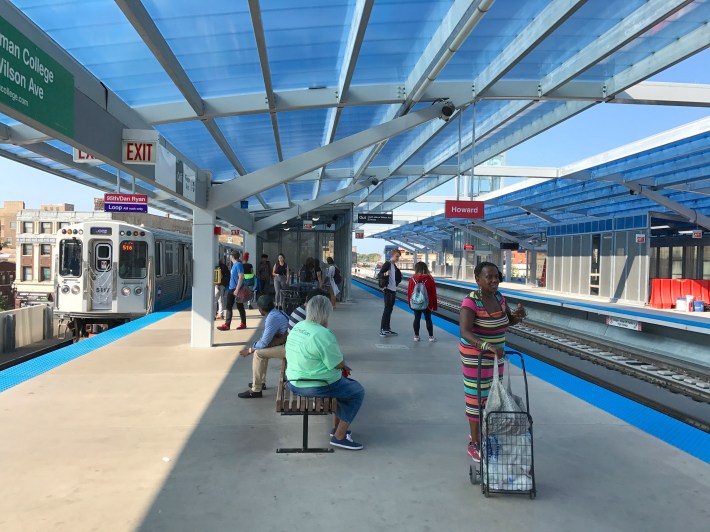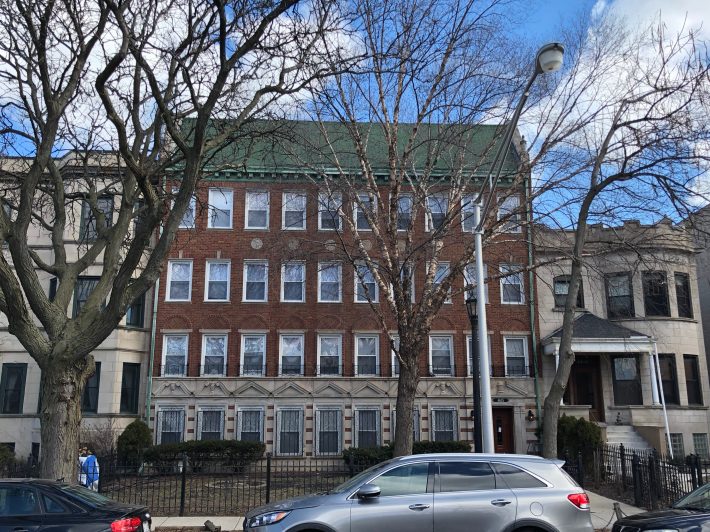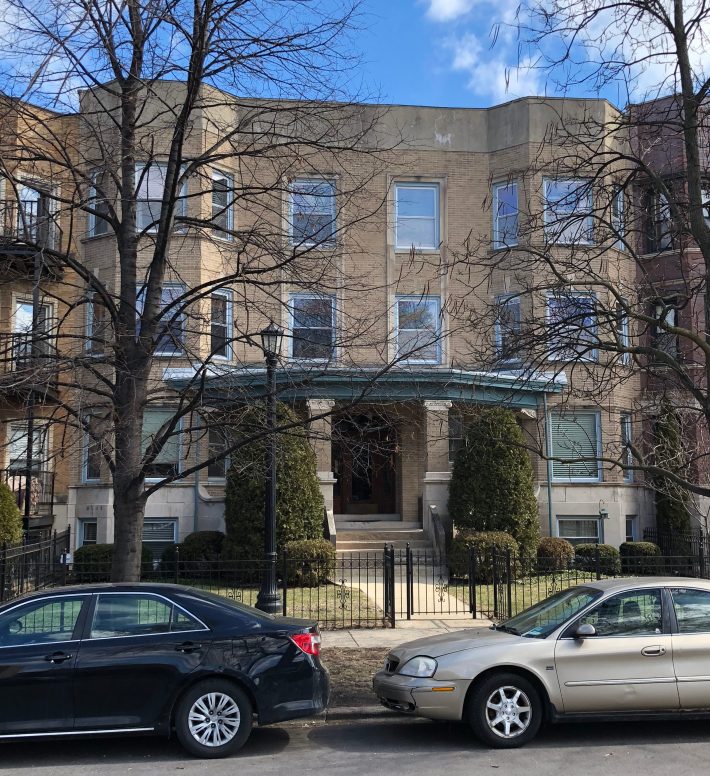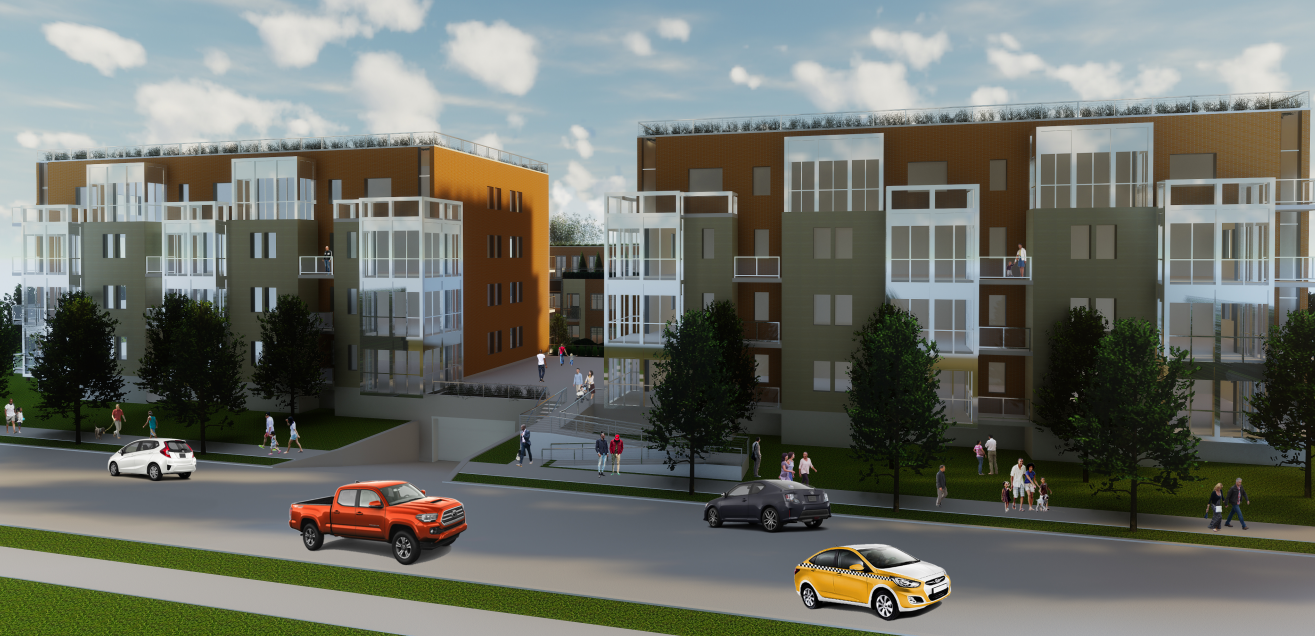A proposed residential development that would have brought 50 mixed-bedroom apartments and 11 townhomes to an empty lot in Uptown has been stalled by 46th Ward Alderman James Cappleman and the Department of Planning and Development for being "too dense". The proposal is less dense than neighboring buildings, and the number of new households it proposes would server bolster the reason for spending $200 million to reconstruct the Wilson CTA station.
Streetsblog reported on the development after a community meeting last July due to its mixed bag of parking accommodations and request for a new street-facing curb cut. The developer planned 25 parking spaces for 50 rental units, a 50 percent reduction from what the zoning code requires. However, the townhomes would each have a 2-car garage, bringing the total number of parking spaces for the site to 47. While the townhome parking would be alley-accessible, the parking garage for rental units would be accessed via a new 22-foot curb cut on Malden St.
Curb cuts are troubling as they introduce a new vehicle conflict point along the sidewalk, and no curb cuts currently exist on the 4600 N block of Malden St. However, neighbors were less concerned with the safety impact of a curb cut, instead rejecting it on the basis that it would remove free street parking spaces. The curb cut is just one of two reasons that the ward office stated the project is on hold.
Members of neighborhood block clubs are principally opposed to the amount of density proposed for the site and the developer’s request for a curb cut.
Tressa Feher, 46th Ward Chief of Staff, stated that the Department of Planning and Development agreed with local opposition to the project on the basis of density. Alder. Cappleman originally made the announcement that it was "placed on hold" by DPD on March 2, 2018, in the ward newsletter "due to the density and curb cut in the front".
The developer is seeking a zoning change from RT-4 to RM-4.5, just one step upward in the zoning code, which permits additional height and density. While the developer would not have been able to construct the originally-proposed building under the existing zoning code, it is also true that many of the buildings on this street would also not have been built under the existing zoning code.
With the recently renovated and capacity-expanding ‘L’ station opening at Wilson, the ward and the city should be doing everything possible to make the most out of this 3-year, $203 million investment. A longtime vacant lot just three blocks from the station is a great location to do so, and would have brought dozens of new residents to a neighborhood that is making several investments in sustainable transportation infrastructure and placemaking, such as the new plaza being constructed at Racine and Broadway.

The ward office’s claim that the Department of Planning and Development finds the development too dense doesn’t make a lot of sense when the proposed development is compared to neighboring buildings. In fact, for a building with 61 proposed units on five lots totalling about 38,690 square feet, the development would have been several times less dense than many existing buildings on Malden St.
When standardized for the typical Chicago lot that's 3,125 square feet, the proposed development is 4.9 units per standard lot size (a concept created by Daniel Hertz). For example, the ubiquitous two-flat graystone is two units per standard lot size.
Several other buildings within one block are more dense:




These existing buildings were built between 1901 and 1930. In the 1923 and 1927 versions of the zoning code, the city permitted buildings as high as 132’ on Malden St, as well as adjoining streets, due to its inclusion in a "volume district". In the 1957 zoning code, established decades after the construction of the above buildings, the street was zoned R5, which allowed a floor-area ratio (FAR, which is how the zoning code measures density of households on a lot) of 2.2. The proposed development has a lower floor-area ratio, making it less dense than what was allowed in 1957.
The developer was seeking to rezone the lot for RM-4.5 zoning, which would have brought its FAR allowance up to 1.7 from 1.2, still below the 2.2 FAR permitted for much of the last century when many of the buildings on the block were constructed.
When most of the existing buildings on Malden and elsewhere in this neighborhood were originally built in the early 20th century, the neighborhood was growing. The Wilson ‘L’ station opened in May 1900, and many buildings were constructed in the decades thereafter. Putting the existing neighborhood zoning in historical context is important when we consider that Uptown is growing again, especially with the reconstruction and expansion of the ‘L’ station. It’s possible that neighbors who complain about the density of a new development are in fact living in developments that are technically more dense.
While the permitted density has decreased over the decades, it is clear that Uptown is becoming a more desirable neighborhood. The city is making multiple investments not only in placemaking but also in terms of transportation capacity. The development, as originally proposed, is hardly pushing boundaries in terms of density, historically and currently speaking. Without allowing this kind of density back into the neighborhood, the city’s investments will not realize their full potential.





